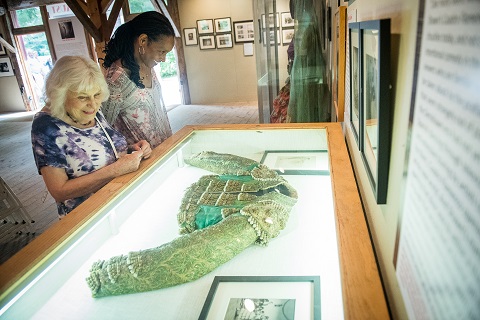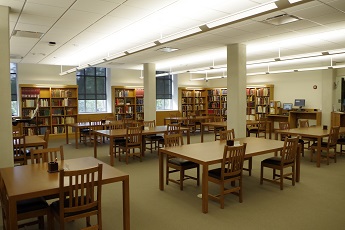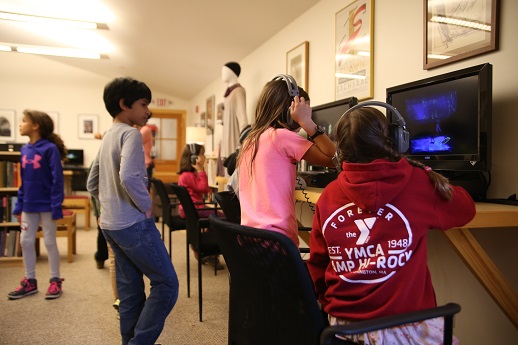Archival Dance Research Guide
Dance archives are rich resources filled with records documenting the history of dance and providing insight into creative processes and cultural contexts. They can provide sources of inspiration and raw material for artists, educators, and scholars.

Norton Owen Reading Room, Jacob’s Pillow, 2019. Photo by Christopher Duggan, courtesy of Jacob’s Pillow.
What are archives?
Archives are collections of mostly unpublished materials, such as choreographic notes, personal letters and papers, video recordings, oral histories, designs, costumes, and photographs. Archives are often housed within larger libraries that hold books, journals, and published media.
Are you looking to delve into archival research but not sure where to start or what to expect? Read on for some tips about how to search for archives and get access to collections. Preparing in advance can help you get the most out of your time in archives.
Check out a glossary of terms used by archives!
Watch Welcome to the Dance Archives: How and Why to Do Research, a free webinar offered by Dance/USA and the Ohio State University’s Lawrence & Lee Theatre Research Institute, featuring artists and archivists in conversation about creative projects that drew on archival research.
NOTE: During the Covid-19 pandemic, many libraries and archives are not currently open for researchers to work on site. To compensate for this, many are providing additional digitization services and remote access.
How do I find archival material on my subject?
- Check out a list of dance archives that are Dance/USA members! The professionals archivists at these sites can help guide your research.
- Entering “[Name] archive” or “[Name] papers” in a search engine will often bring up results from library and archive catalogs.
- Libraries use Finding Aids to describe archival collections. You can view online finding aids through library catalogs, and they will provide an overview of the collection and a detailed description by box or folder.
- Libraries also create subject-specific Research Guides listing the resources they hold in different areas. You should be able to browse Research Guides on the institution’s website.
- Search ArchiveGrid: a consortium database representing more than 1,000 archival institutions.
- Regional or subject-specific databases like the Online Archive of California or Umbra Search for African American History allow you to search across multiple institutions grouped by geographic region or subject.
- OCLC WorldCat: the largest national library database mainly for books and regular library materials.
- Looking for digital archives? Many institutions have some of their collections online in a digital library. Check out the Digital Public Library of America and statewide digital libraries such as Calisphere https://calisphere.org/
- Tip: look at a biography or book about your subject and see what archives are cited in the acknowledgments or notes.
- If you want to search by subject, be aware that libraries and archives use subject headings to tag records so that researchers can search by subject (e.g., dance genres like tap or Butoh, subjects such as African Americans in ballet) Many institutions use Library of Congress Subject Headings. If your searches are not bringing anything up, try varying your search term, or use the LCSH database to find the approved term.
- If you are having trouble finding materials on your subject, ask library or archives staff for help with your research.

Visitors to the Dance We Must exhibition, Jacob’s Pillow Archives. Photo by Christopher Duggan, courtesy of Jacob’s Pillow
How do I contact the archives?
- Library/archive websites will usually have a contact link or generic email on their website, but you should try searching the site for “subject librarians” and/or “research guides” to find the most appropriate person.
- Try to contact the department most closely related to the materials you are interested in. If they can’t help you access materials, ask if they can connect you to the department who can.
- Some archives require users to demonstrate that they have a legitimate research project. You should NOT be required to have an affiliation to an academic institution; you can identify yourself as an independent scholar or artist.
- Having trouble reaching an archive? Contact Dance/USA’s archiving team, and we can try to help you connect!
How do I find out who owns the rights to the materials?
- Know that archives do not always own copyright to the materials in their collections.
- First, check the finding aid or catalog record for basic rights information. If it’s unclear, ask librarians/archivists at the institution.
- If you want to get permission to use or publish materials, start by asking the archive if they know who holds the rights and if they can provide you with contact information.
Will I have to pay to get access to things?
- Most archives will not charge you to come in and look at materials they hold. There may be fees for digitizing or copying materials.
- If you want to publish materials (on a website or in a publication) or use them in a performance you may have to pay a fee to the rights-holder to license them, and you may need to give an attribution to the archive.
- Libraries and archives sometimes offer research fellowships or stipends to offset the cost of traveling to do research. Ask what’s available!

Thompson Special Collections Reading Room at the Ohio State University Libraries. Photo courtesy of the Ohio State University Libraries.
How should I prepare for my visit?
- Most archives and Special Collections can only be used onsite in a reading room, you cannot check them out. If you cannot travel to the site, ask whether the archive might be able to digitize the item(s) for you.
- Most research libraries and archives don’t let you enter the spaces where materials are stored. To access archival materials, you will need to search for items online, request them, and they will be delivered to you. Ask staff for help if you can’t find what you want.
- Be sure to check whether you need to request materials in advance; some materials may be offsite and cannot be requested for same-day delivery. This information should be in the catalog record (it will say something like “Available,” “Advance request,” or “Use on site.”) If you are unsure, email or call the archive to ask.
- You may be required to show a government-issued ID, and/or obtain a library card to use the collection, even if you are not checking things out.
- You may be required to check all bags, coats, etc. to enter the reading room. If you require any special accommodations, you may want to let them know beforehand, or when you arrive.
- Food and drink (even bottled water) are never allowed in reading rooms, so plan to eat and hydrate beforehand.
- Common policies when viewing materials onsite include viewing only one item at a time, handling materials carefully, and retaining the order materials came in.
- Good notes are your friend when doing research in a reading room in case you need to return to the material later. Make sure to note the folder number where you found things. Bring paper and a pencil (pens may not be allowed in reading rooms.)
- Many libraries and archives allow you to take your own digital photos of materials for research use only, but some materials may be off-limits. It’s safest to ask! Remember that permission to take photos does not equal permission to publish those photos.
- If you are unfamiliar with the “rules” of an archive, don’t hesitate to ask the staff. They are there to help you.

Norton Owen Reading Room, Jacob’s Pillow, 2018. Photo by Noor Eemaan, courtesy of Jacob’s Pillow
How do I cite my archival sources?
- However you are using archival materials, it is important to cite your sources!
- In general, for unpublished archival materials, you will want to cite the author, a title (use a short description if there is no title on the item), the collection it comes from, the subseries (if any), box or folder name and number if applicable, and the repository name (i.e., the library or archive institution).
- For how to cite a specific collection or repository, check the website of the library to see if they provide a preferred citation, or email or speak with staff there and ask for the preferred citation format. Some libraries have online LibGuides which provide this information.
- If you cannot find an example for the type of format you want to refer to (for instance, a videotape of a TV show), you may adapt the example that is closest in your preferred style guide (MLA, APA, Chicago).
- Provide as much information as possible to help other researchers find the materials.
- Refer to the date you accessed the materials, especially for any online sources.
- MLA guide to citing archives in digital archives.
- MLA sample of citing a video found online.
More resources:
- Dalhousie University Archives guide.(MLA, Chicago, and APA)
- Purdue OWL Citing Archival Research Guide (part of a larger Archival Research guide)
- Marquette University Guide to Archival Sources (MLA, Chicago, APA, and Turabian)
- MLA Guide to Citing Materials from Physical Archives and Collections
